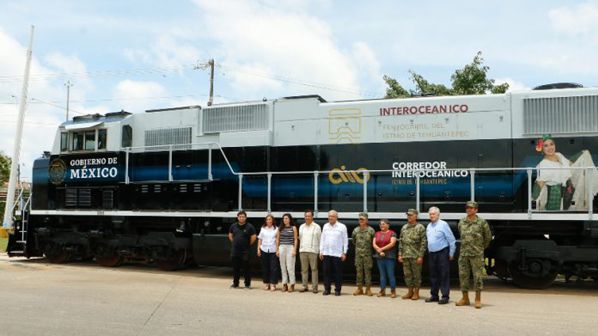Mexico’s government has embarked on a daring venture to rejuvenate a historic railway, dormant for over a century, connecting the Gulf of Mexico to the Pacific Ocean. The aim is to divert container traffic away from the Panama Canal.
This initiative capitalizes on the increasing inclination of multinational corporations to be in closer proximity to the United States and the Panama Canal’s susceptibility to low water levels due to more frequent regional droughts. For populist President Andrés Manuel López Obrador, this project is part of a strategy to attract investment to the economically disadvantaged southern regions, though industry experts remain skeptical about its prospects.
The $2.8 billion Tehuantepec Isthmus Corridor will feature a 308-kilometer railway linking refurbished ports in Salina Cruz, Oaxaca state, and Coatzacoalcos, Veracruz, along with industrial zones strategically located near transportation hubs, including airports. Test runs have already been conducted on this route, with its official opening scheduled for December.
The Mexican government is optimistic about the potential of this rail connection, offering proximity to the United States and a transit time of 6.5 hours, excluding loading time – significantly less than the eight to 10 hours required for the 80-kilometer canal journey.
Economy Minister Raquel Buenrostro expressed confidence in Mexico’s attractiveness on the global stage, saying, “Mexico right now is one of the most attractive countries, among the top five most attractive in the world. There’s no way that this doesn’t develop.”
However, experts caution that it may take years to establish the necessary infrastructure and supporting industries to entice major global logistics players, if that goal is achievable at all. The additional expenses, time, and security concerns involved in transferring containers from ships to trains (with a fraction of a ship’s capacity) and back to vessels at Coatzacoalcos on the Gulf of Mexico present significant challenges, according to figures in the logistics industry.
Despite Mexico’s significant investment in the project, there is a noticeable lack of interest from international shipping companies, freight groups, and port terminal operators in the newly revived rail route, according to reports. The government suggests that the initial wave of industrial parks will mainly attract Mexican investments. The success of this corridor will ultimately depend on the establishment of sustainable industries in the southern region of the country.
Lars Ostergaard Nielsen, the head of Americas customer delivery at AP Moller-Maersk, the world’s second-largest container shipping group, highlighted the importance of manufacturing investments as a catalyst for the corridor’s viability. He mentioned, “The day that our customers have decided to invest in manufacturing, that would drive demand potentially that could be interesting for us.” Nielsen emphasized that increased manufacturing activity in the region would make the interoceanic corridor more valuable, but in the absence of such a trend, there would be limited demand for the rail link.
Economic Minister Raquel Buenrostro disclosed that Mexico has allocated approximately 50 billion pesos to the project, covering expenses related to railway upgrades, land acquisition for industrial parks, and the procurement of machinery and rolling stock. Auctions for industrial park sites witnessed the participation of twelve primarily Mexican companies, with 30 bids placed across five different locations.
Construction is slated to commence next year, potentially generating 10,000 direct jobs, as revealed by an official statement. The optimism is high that the industrial parks associated with the project will naturally flourish.
This year, the Panama Canal faced one of the most severe droughts in its history, relying heavily on freshwater resources for its daily operations. As a result, weight restrictions were imposed on crossings, and for the first time, the daily ship crossing limit was reduced from an average of 36 to 31.
In August, the waiting times for larger tankers carrying liquefied natural gas through the canal surged to as much as 20 days, a notable increase from the eight days recorded in the same month in 2022, according to shipping agency Norton Lilly. However, regular container traffic, which Mexico aims to attract, was less affected due to advanced booking practices.
Mexico’s government perceives the challenges faced by the Panama Canal, which generated $4.65 billion in revenue last year, as a strategic opportunity.
In its initial phase, the single-track rail line will accommodate both passenger and cargo trains concurrently. The six cargo trains can transport 260 TEUs (Twenty-foot Equivalent Units, a cargo capacity measurement) on two daily trips, resulting in a maximum annual capacity of 1.14 million TEUs. While this falls significantly short of the 10.9 million TEUs transported by container ships through the Panama Canal in 2022, the government sees the rail as an increasingly crucial alternative, especially given the climate change-related shifts.
Projections from a September presentation estimate that 304,688 TEUs will pass through the Isthmus corridor by 2028, with a substantial increase to 1.3 million TEUs by 2036. The director of the canal, Ricaurte Vásquez Morales, acknowledges the potential competitive threat posed by the Mexican project in the improbable scenario of the canal running out of water.
In a recent press conference, it was acknowledged that the Mexican solution could indeed pose a potential challenge to Panama’s operations, although it’s emphasized that a replacement route would only be considered under extreme circumstances where water scarcity is an issue, an outcome not foreseen.
To address the current challenges, Panama has already established road and rail transportation options across its isthmus. The canal authority has also explored the possibility of a new reservoir project to ensure a steady supply of freshwater.
President López Obrador’s vision for the isthmus region is part of a broader plan to revive Mexico’s passenger railways, which largely fell into disuse during the 20th century. The Tehuantepec line, originally built by a British engineering firm for the government of dictator Porfirio Diaz and inaugurated in 1907, faced setbacks due to Mexico’s revolution and the subsequent opening of the Panama Canal in 1914.
Ultimately, the isthmus railway will link to President López Obrador’s $30 billion Mayan Train loop, designed for tourism, and an $18 billion new oil refinery, all part of an effort to distribute wealth through government mega-projects. The operation of most of these initiatives has been entrusted to the country’s armed forces, with the Tehuantepec corridor overseen by the navy.
In May, the marines took control of a segment of the railway that was under concession to Grupo Mexico, which was meant to contribute to the network’s expansion. This move had a negative impact on private investors’ confidence. Additionally, talks regarding Grupo Mexico’s acquisition of Citigroup’s Mexican unit, Banamex, fell apart during the same week.
Meeting the traffic targets for the railway will be a challenge without the presence of ports capable of efficiently handling increasingly larger ships. Smaller vessels would incur higher costs and environmental implications per container. Building the necessary port capacity, which requires over $400 million in investment, is seen as a risky endeavor without a clear market.
Despite these challenges, there is a growing interest from logistics operators in expanding the ports at both ends of the rail route. They are keenly observing which industries will establish themselves along the corridor.
(Source: The Week US | Christine Murry | Oliver Telling | FT)









